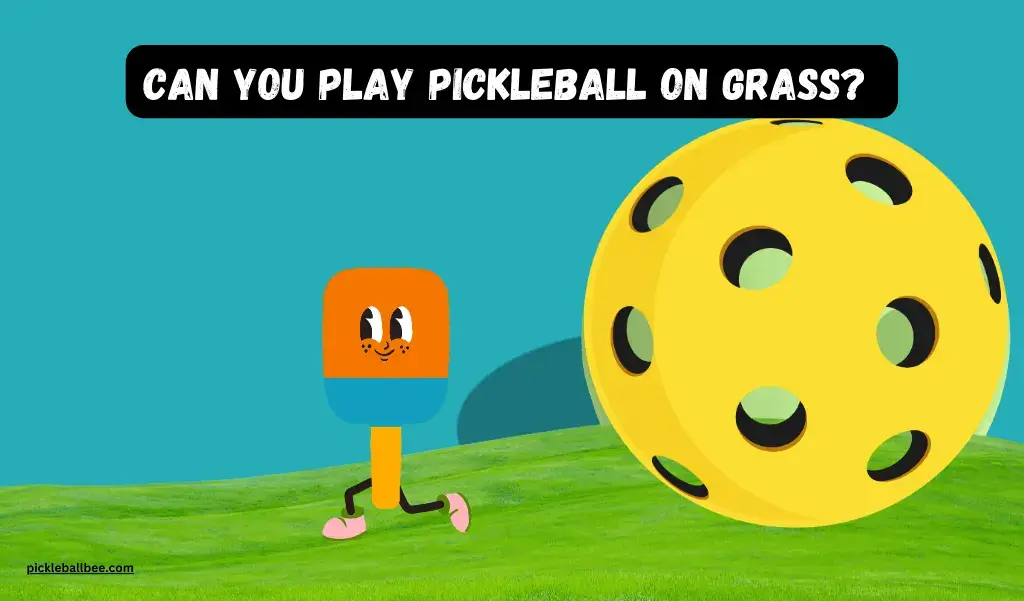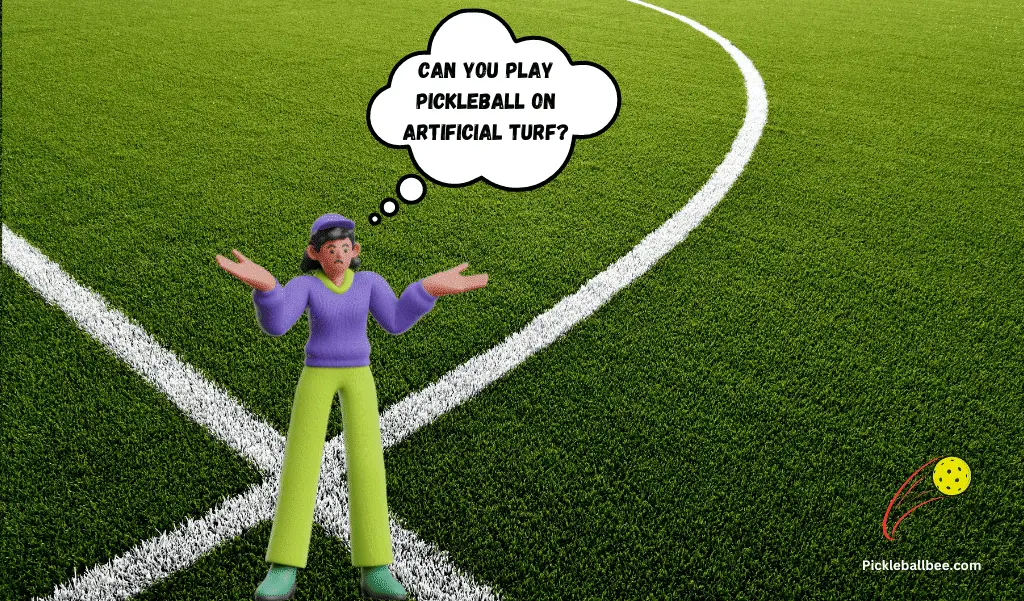Pickleball is a fun mix of tennis, badminton, and table tennis, usually played on indoor or hard outdoor courts. But what about playing it on the grass? This idea brings a fresh, soft touch to the game. Playing on grass is easier on the knees and joints, which is great for players of all ages. It also lets players enjoy the game in a natural, peaceful outdoor setting, away from the usual hard courts.
However, playing on grass has its own set of challenges. The grass can be uneven, the ball bounces differently, and keeping the lawn in good shape is important. Despite these challenges, playing pickleball on grass could be a fun new way to enjoy the game. It’s a step into a softer, greener playing field that might just bring new excitement to pickleball. So, it’s worth exploring this new way of playing, and who knows, grass courts could become a new favourite among pickleball enthusiasts!

Table of Contents
Can You Play Pickleball on Grass?
Absolutely! You can play pickleball on the grass! It’s a refreshing change from the usual hard-court game. The soft grass is easier on your knees and joints, making it a friendly option for people of all ages. Plus, there’s something really enjoyable about playing in a natural, outdoor setting—it’s a laid-back, fun vibe.
But remember, the game will feel a bit different on grass. The ball won’t bounce as high, and if the lawn has some bumps or uneven spots, you’ll get some quirky bounces to deal with. It’s a good idea to have a well-kept, flat lawn to make the game enjoyable.
A little prep work, like marking the court and setting up a net, and you’re in for a good time. So, grab your paddle, call your friends, and give pickleball on the grass a whirl. It’s a cool way to enjoy the game in a new, relaxed way!
Can grass be used to play pickleball?
Yes, grass can serve as a fun and unconventional surface for a game of pickleball. It offers a softer landing for your feet, making it a gentle choice for players. The lush green setting can make the game feel more relaxed and enjoyable, especially on a bright, sunny day.
However, playing on grass does come with its quirks. The ball doesn’t bounce as predictably as it does on hard courts, and a bumpy lawn can add a touch of surprise to your game. It’s wise to choose a well-tended, level lawn to minimise unexpected hops and skips.
A little groundwork, like setting up a net and marking the court boundaries, and you’re ready to dive into a game of pickleball on grass. It’s a delightful variation of the traditional game, offering a blend of challenge and fun amidst a natural backdrop. So, if you’re up for a little adventure, why not give it a shot? It’s a refreshing way to enjoy pickleball with a twist!
How to make a pickleball court on grass?

Setting up a grass pickleball court can be a fantastic weekend project that brings a fresh twist to the game. Start by selecting a flat area in your yard, as a level surface will ensure more predictable play. Once you’ve found the perfect spot, mow the grass short to improve the ball’s bounce and roll. Now, it’s time to mark the Court dimensions. A standard pickleball court is 20 feet wide and 44 feet long. You can use spray paint or simple chalk to draw the lines on the grass, marking the boundaries and service areas.
For the net setup, you have a couple of options. You can buy a portable pickleball net from a sports store or online, which is a quick and easy solution. Alternatively, if you’re looking to save some money, you can create your own net using some poles and netting. The net should be 36 inches high at the sides and 34 inches high in the middle to adhere to standard pickleball court specifications. Additionally, considering a portable pickleball court over grass is a great idea as it allows for a quick setup and takedown, making it a convenient choice for spontaneous games.
Next on the list is marking the non-volley zone, which is the area 7 feet from the net on both sides where volleying is not allowed. You can use the same spray paint or chalk to mark these lines, ensuring clarity during gameplay.
Now, you’re almost ready to play! Before you dive into a game, check all your lines and adjust your net to make sure everything is set up correctly. It might take a little time to get everything perfect, but the effort is well worth it. Once everything is in place, call over some friends, grab your paddles, and enjoy a fun game of pickleball on your new grass court! Your backyard will now be the hub for many enjoyable pickleball games to come.
Also Read: Can You Play Pickleball On Artificial Turf?
Advantages of Playing Pickleball on Grass
- Playing pickleball on grass is like having a natural cushion under your feet. Unlike hard courts, grass is soft and forgiving, which means it’s easier on your joints. You won’t feel that harsh thud every time you jump or run. This is especially good news for your knees and ankles. It also lowers the chance of getting hurt if you take a tumble. So, it’s a safer choice, especially for a lively game of pickleball.
- This softness makes grass courts a great choice for players of all ages. Whether you’re a grandparent or a grandkid, playing on grass is gentle and enjoyable. It’s a way to keep the game going for everyone, no matter their age.
- There’s something special about playing pickleball in the great outdoors, especially on a grass court. The fresh air, the greenery around, and the open sky make the game feel refreshing and enjoyable. It’s a calm and peaceful setting that adds a nice touch to the game. It’s like having a fun day out in the park while enjoying a game of pickleball with friends and family.
- Besides the fun, playing on grass is also a thumbs up for the environment. Unlike concrete or asphalt courts, grass courts don’t need materials that can be harmful to nature. Plus, grass is good for the soil and the air. It’s a way to enjoy a game of pickleball and be kind to Mother Earth at the same time!
Also Read: Can You Play Pickleball On Concrete
Challenges of Playing Pickleball on Grass
When playing pickleball on grass, you might find that the surface isn’t as smooth as a traditional court. Bumps and holes in the grass can make the ball bounce and roll in unexpected ways. This can be a bit tricky and might take some getting used to. It’s a different challenge that adds a twist to the game.
To make the game more enjoyable, you might want to choose a part of the lawn that’s fairly level and free of holes. Filling in any noticeable holes and flattening out bumps can also help. It might take a little extra work, but it will make your game more fun and less frustrating.
Keeping a grass court in good shape requires some care. Regular mowing to keep the grass short, filling in holes, and maybe even some watering during dry spells will keep your court playable. It’s a bit like having a small garden; it needs some love and attention to stay nice.
When you compare this to a hard court, maintenance is a bit more hands-on. Hard courts need sweeping and maybe some crack repair, but they don’t need mowing or watering. However, the extra effort for a grass court pays off with a soft, natural playing surface that’s easy on the joints and pleasing to the eye. Plus, it’s a great way to enjoy the outdoors while playing your favourite game!
Can pickleball bounce on grass?

Yes, pickleball can bounce on grass, but it’s a bit different than on hard courts. The bounce is usually lower and can be a bit unpredictable if the grass is uneven or has bumps. It’s part of what makes playing on grass a unique experience. The softness of the grass absorbs some of the ball’s energy, making the bounce less lively. It might take a little getting used to, especially if you’ve only played on hard courts before. But with a bit of practice, you’ll get the hang of it.
Choosing the right pickleball ball for grass play is crucial for a good game. Typically, a ball with a slightly harder exterior and more bounce is preferred for grass courts. This is because grass has a softer surface and can dampen the bounce of the ball. A ball like the Penn 40 Outdoor Balls which is known for its bounce and durability, could be a good choice. Also, it’s a good idea to go for a ball with a bright colour, like neon or white, so it stands out against the green grass, making it easier to see during play.
Lastly, it’s always a good idea to check with local players or clubs who might have experience playing on grass. They could have some valuable insights on which ball performs best on grass courts in your area. So, with the right ball, you’ll be all set for a great game of pickleball on grass!
Players’ and experts’ opinions
When it comes to playing pickleball on grass, both players and experts have some interesting thoughts to share.
Sharing experiences from players:
Many players who have tried playing pickleball on grass find it to be a refreshing change. They often talk about how the soft grass is easier on their feet and joints, making the game less strenuous. Some enjoy the natural, outdoor setting, which adds a relaxed vibe to the game. However, a few also mention the challenge of dealing with an uneven surface, which can make the ball bounce in unexpected ways. It’s a bit of a mixed bag, but the general feeling is that playing on grass is a fun variation, especially for friendly, casual games.
Expert opinions:
Experts, too, have their own take on this. Some believe that grass courts could be a great way to introduce more people to pickleball, especially those who might find hard courts too tough on their bodies. They also see potential in grass courts for community events or local tournaments, adding a unique charm to the competition. However, they also point out the maintenance aspect, stating that keeping a grass court in good shape requires a bit more effort compared to traditional courts.
As for the future, some experts feel that with the right maintenance and perhaps some innovations in court levelling and turf technology, grass courts could become a more common sight in the pickleball community. They see it as an exciting opportunity to blend the traditional charm of grass courts with the modern, fast-paced fun of pickleball.
Can you play pickleball on wet surfaces?
Playing pickleball on wet surfaces isn’t the best idea. When the court is wet, it can become slippery, and that’s a recipe for slips and falls, which nobody wants. Besides, the ball won’t bounce or behave as it usually does on a dry court, which can mess up the game. It’s always safer and more enjoyable to play pickleball when the court is dry. If it has rained, it’s worth waiting for the court to dry up or mopping it dry if you’re in a hurry to play. Safety should always come first, so it’s better to avoid playing on wet surfaces to ensure everyone has a good time and stays injury-free.
conclusion:
Setting up a grass pickleball court opens up a refreshing, natural setting for the game, making it accessible and enjoyable for players of all ages. While the softer surface is gentler on the joints, the unique bounce and maintenance of a grass court add a new layer of challenge and engagement to the game. With a bit of preparation, like choosing a more bouncy ball and ensuring a level playing field, playing pickleball on grass can be a delightful experience. It’s a wonderful blend of traditional charm and modern gameplay, offering a fresh perspective on the ever-evolving game of pickleball.
FAQs:
-
Can pickleball be played on Artificial turf?
Yes, pickleball can be played on turf. The softer surface is gentle on the joints, though the ball’s bounce may be less predictable. It’s a fun variation, offering a unique challenge and a refreshing outdoor playing experience.
-
Can pickleball be played on dirt?
Playing pickleball on dirt isn’t ideal. The uneven and loose nature of dirt can affect the bounce and roll of the ball significantly, making the game unpredictable and less enjoyable. It’s also likely to be quite messy. It’s always better to play on a more solid and smooth surface like a traditional court, grass, or even a well-packed clay court to ensure a good game.
-
Can Pickleball be Played in the Rain?
Playing pickleball in the rain is not recommended. Wet conditions make the court slippery and dangerous, increasing the risk of slips and falls. Additionally, the rain can affect the ball’s bounce and the players’ ability to move quickly and safely. It’s always best to wait for dry conditions to ensure a safe and enjoyable game.


